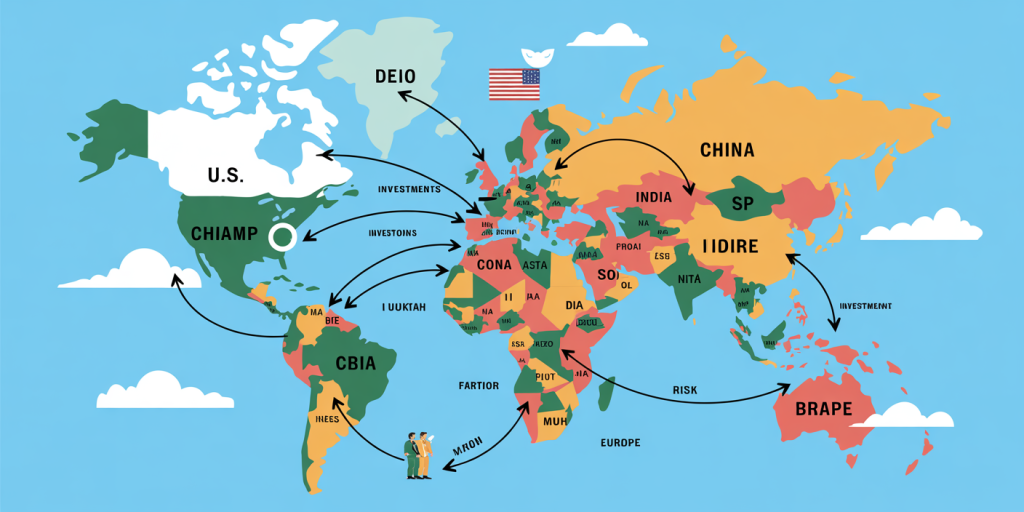How to Build a Diversified Investment Portfolio
Anúncios
In the dynamic landscape of financial markets, building a diversified investment portfolio remains one of the most effective strategies to mitigate risk and enhance long-term returns. Investors from beginners to seasoned professionals often grapple with how to allocate assets properly, balancing growth opportunities against potential downturns. Diversification involves spreading investments across various asset classes, sectors, and geographic regions to reduce exposure to any single asset’s volatility. This article explores practical steps, backed by data and real-life examples, to help investors construct a well-rounded and resilient portfolio.

Understanding the Importance of Diversification
Anúncios
Diversification is the cornerstone of modern portfolio theory, which suggests that spreading investments across uncorrelated assets can reduce overall portfolio risk without sacrificing returns. According to a 2023 CFA Institute report, diversified portfolios can lower volatility by up to 30% compared to concentrated positions, while delivering comparable or improved performance.
For example, an investor holding only technology stocks like Apple or Tesla faces significant risk during sector downturns, as seen during the tech sell-offs in early 2022. Conversely, a portfolio including bonds, real estate, and international equities can soften those shocks, allowing the investor to capitalize on strengths in other areas.
Diversification is not merely about asset quantity but also about choosing assets that behave differently under varying economic conditions. During the 2008 financial crisis, for instance, U.S. equities plummeted approximately 37%, while U.S. Treasury bonds yielded positive returns, proving safer assets can safeguard portfolios during market stress.
Asset Allocation: The Foundation of Portfolio Diversification
The first step in diversification is determining an appropriate asset allocation based on investment goals, risk tolerance, and time horizon. Asset allocation dictates how much of the portfolio is placed in equities, fixed income, real estate, cash, and alternative investments.
A classic example is the 60/40 portfolio: 60% stocks and 40% bonds. Historically, this mix has delivered balanced growth and risk mitigation. Data from Morningstar indicates that from 1990 to 2020, a 60/40 portfolio yielded an average annual return of 8.2% with about 10% annual volatility, compared to equities alone, which returned 10.5% but experienced volatility over 15%.
Investors with higher risk tolerance and longer time horizons might allocate more to equities and alternative investments like private equity or commodities. Conversely, conservative investors close to retirement often increase bond and cash holdings to preserve capital. In all cases, diversification within each asset class is equally critical—for example, owning a mix of growth and value stocks, or government and corporate bonds.
Geographic Diversification: Expanding Beyond Borders
Focusing solely on domestic markets can expose investors to country-specific risks, including economic downturns, political instability, and currency fluctuations. Geographic diversification spreads risk across different regions, capturing growth in multiple economies.
For instance, U.S. stocks have dominated global equity markets for decades, but the MSCI World Index reveals that U.S. equities account for about 60% of its capitalization. Adding emerging markets like China, India, and Brazil introduces growth potential but also increased volatility. According to MSCI, emerging markets delivered 9.5% annualized returns over the past 20 years, albeit with 20% standard deviation compared to 14% for developed markets.
To illustrate, an investor with 70% exposure to U.S. stocks and 30% in international equities saw their portfolio outperform global downturns in 2015 when China’s markets slumped but the U.S. continued steady gains. Geographic diversification can be implemented easily through international ETFs or mutual funds, which offer built-in exposure to multiple countries.
Sector Diversification: Spreading Risk Within Markets
Within domestic or international markets, sector diversification reduces the impact of cyclical downturns in specific industries. The global economy comprises sectors like technology, healthcare, energy, utilities, finance, consumer discretionary, and more, each responding differently to economic and market forces.

Consider the energy sector during the COVID-19 pandemic when oil prices dropped sharply in 2020, significantly impacting portfolios concentrated in energy stocks. Conversely, healthcare and technology sectors experienced growth due to increased demand and innovation. Data from S&P Dow Jones Indices shows technology stocks yielded a 27% average return in 2020, while energy stocks lost about 33%.
A diversified portfolio typically spreads equity holdings across various sectors according to market capitalization or personal conviction. Using sector ETFs can help individual investors allocate efficiently without buying stock-by-stock. Below is a comparative table of sector performances in 2020 to highlight the impact of sector allocation on portfolio performance:
| Sector | 2020 Return (%) | Volatility (%) |
|---|---|---|
| Technology | +27 | 25 |
| Healthcare | +13 | 18 |
| Consumer Staples | +6 | 12 |
| Utilities | +2 | 14 |
| Financials | -17 | 28 |
| Energy | -33 | 45 |
This example underscores the need to balance sectors to protect portfolios during market upheaval while capturing growth where opportunities arise.
Incorporating Alternative Investments for Enhanced Diversification
Traditional portfolios often focus on stocks and bonds, but including alternative investments can provide additional layers of diversification. Alternatives include real estate, commodities, hedge funds, private equity, and even cryptocurrencies.

Real estate, often accessed via Real Estate Investment Trusts (REITs), tends to have low correlation with equities, providing income and inflation protection. For example, over the past decade, U.S. REITs have earned an average annual return of around 9%, with correlations to S&P 500 stocks close to 0.5, indicating moderate diversification benefits.
Commodities like gold and oil can act as hedges against inflation and geopolitical risk. Gold, in particular, has a near-zero or negative correlation with stocks in many periods, making it a favored safe haven. During the 2008 financial crisis, gold gained 5%, while equities fell sharply.
Including alternatives requires careful consideration of risks, fees, and liquidity. While they enhance diversification and potential returns, alternatives may come with higher volatility and longer lock-in periods. Therefore, a balanced approach placing alternatives between 5%-15% of total portfolio value can optimize benefits without undue risk.
The Role of Regular Rebalancing in Maintaining Diversification
Building a diversified portfolio is not a one-time event but an ongoing process requiring periodic review and rebalancing. Market movements can cause drift in asset allocation, leading portfolios to become overweight in riskier or underperforming assets.
For instance, if equities outperform bonds significantly during a bull market, a 60/40 portfolio might shift to 70/30, increasing exposure to market risk. Conversely, during bear markets, bonds may dominate, causing missed growth opportunities. Rebalancing involves selling overweight assets and buying underweight ones to restore target allocations.
According to a Vanguard study, disciplined annual rebalancing enhanced portfolio returns by an average of 0.5% to 1% per year over 20 years, while reducing volatility. Rebalancing can be automated with many robo-advisors or done manually after periodic reviews, ideally semi-annually or annually.
Practical implementation involves setting tolerance bands—for example, a 5% deviation from target weights—that trigger rebalancing. This strategy also enforces a “buy low, sell high” discipline, supporting investment goals amid market fluctuations.
Looking Ahead: Future Trends in Portfolio Diversification
Investment landscapes are constantly evolving, influenced by technological advances, geopolitical shifts, and regulatory changes. As artificial intelligence, ESG (Environmental, Social, Governance) investing, and blockchain technologies gain traction, portfolios will need adaptation to maintain diversification and seize emerging opportunities.
ESG investing, for example, integrates sustainability criteria into asset selection and has seen inflows exceeding $500 billion in 2023 alone. This approach not only diversifies financially but aligns investments with ethical and environmental values, appealing to new generations of investors.
Additionally, the growth of thematic ETFs centered on innovation sectors such as clean energy, biotechnology, and AI presents both diversification opportunities and new sector risks. Investors must balance enthusiasm for innovation with prudent allocation to established asset classes.
Advances in data analytics and AI-driven portfolio management tools also empower investors with more precision, allowing dynamic diversification strategies customized to real-time market conditions and personal preferences.
With global markets becoming increasingly interlinked, diversification must evolve beyond traditional frameworks to include new asset classes, geographic frontiers, and sustainable choices. Investors who remain adaptable and diligent in managing their portfolio diversification position themselves for resilience and success in a changing world.
